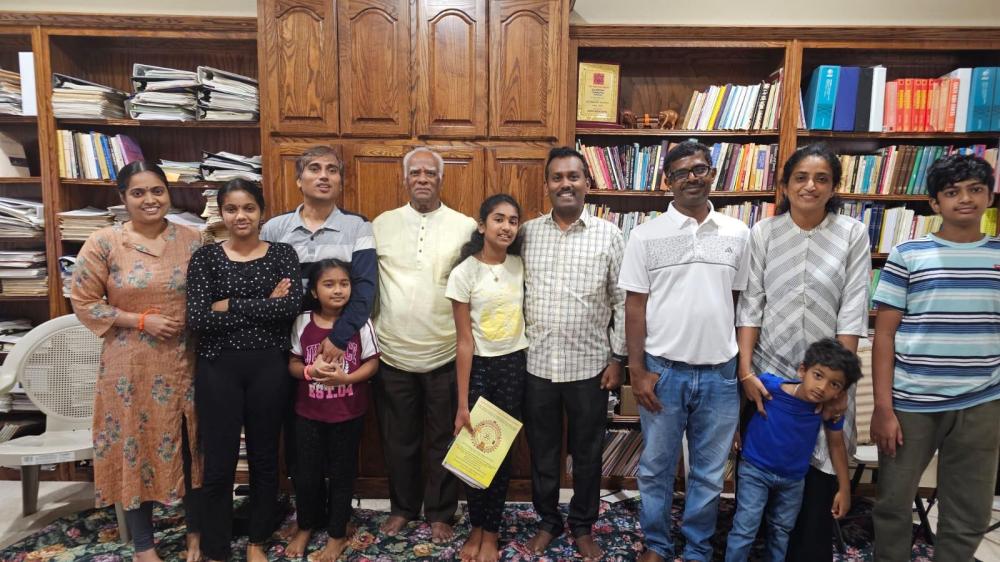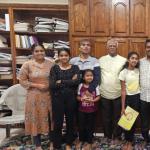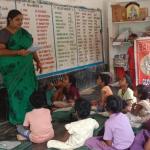The Global Hindu Heritage Foundation has written several letters to the TTD Board Chairman, TTD Executive Officers, Endowment Department Commissioners, the Minister for Endowments, Chief Ministers, and other officials over the past 18 years. We met in person with the then Chief Minister, Sri Y.S. Rajasekhar Reddy, in Chicago in 2007, with Sri Karunakar Reddy in 2007, and with Sri Chandrababu Naidu in 2008, accompanied by Dr. Subramanian Swamy.
GHHF invited Sri C Ramachandraiah, the then Minister for Endowments to Dallas, Texas and had a marathon conference for six hours to discuss all about our concerns about TTD in 2012; met Sri Chadalavada Krishna Murthy, the Board Chairman in Fisco Texas in 2015; met Sri Manikyala Rao, the then Minister for Endowments in 2016 and 2017; Sr S V Subba Reddy, TTD Board Chairman in Frisco Texas in 2019; Sri Anil Kumar Singhal on December 23 in 2019; Sri Velampalli Srinivas, the then Endowment Minister in 2020; and other Endowments officials to talk about several issues, particularly about the presence of Christians working at TTD.
In fact, at the request of late Sri P V RK Prasad Garu, Prasad Yalamanchi and I attended Dharmika Sadas twice and submitted an article on Rampant Christian Conversions.
In all our meetings with these officials and the several letters we have submitted to TTD officials, the theme of GHHF remains the same. Approximately 20 percent of Christians work at TTD. We requested each time that they identify Christians working at TTD and remove them.
Not a single official we mentioned above ever disputed our claim that 20 percent of the employees of TTD are Christians, and they should identify and remove them. L. V. Subramanyam, the then Chief Secretary of Andhra Pradesh, the present Chief Minister, Sri Chandrababu Naidu, TTD Board Chairman Sri B.R. Naidu, and Executive Officer Sri J. Shyamala Rao openly stated that only Hindus should work at TTD. They asked all non-Hindus to transfer to other departments on a voluntary basis. Nothing worked.
TTD has identified approximately 18, or possibly a few more, in the last three months and suspended them. That is not even one percent of the suspected Christians working at TTD.
CONTROVERSY OVER THE NUMBER OF Non-Hindus WORKING AT TTD
• On July 10, Sri Bandi Sanja Kumar, Minister of State for Home Affairs, alleged that 1,000 non-Hindus are working at TTD without having faith in Lord Venkateswara or adhering to Sanatana Dharma. He called for an immediate probe to identify and remove non-Hindu employees from TTD. He further stated that his demand was not a request, but a firm stance. He requested Sri B R Naidu to ensure that only Hindus are employed.
• Sri Bhuma Reddy, ex-Chairman, strongly criticized Bandi Sanjay’s claim that TTD employed over 1,000 non-Hindus. But he never mentioned how many Christians are working at TTD. He was there for about two years, but he did not know how many Christians were working.
• Sri Bhanu Prakash Reddy, the present Member of TTD Board defending the Minister, went further, saying that the number of non-Hindus working at TTD might exceed 1,000. He said, “While some staff may carry Hindu names, symbols of other faiths are visible in their homes, and called for a house-to-house verification survey.
NO SERIOUS EFFORT WAS MADE BY TTD TO IDENTIFY CONCEALED CHRISTIANS.
Every Chief Minister, TTD Board Chairman, and executive officer knows fully well that thousands of Christians work at TTD. It is not politically palatable for government officials to conduct a thorough investigation. For nearly 15 years Global Hindu Heritage Foundation is saying that as many as 20 percent of TTD employees are Christians hurting the sentiments of Hindus, vitiating the sanctity of Balaji Temple, demeaning our Gods, making fun of Hindus worshipping different Gods and so.
Nobody wants to bell the cat. Put it roughly, that nobody has the guts, commitment, will, determination, passion, and courage to investigate or take steps to identify non-Hindus.
How Many Employees are working at TTD?
TTD Board member Sri Bhanu Prakash Reddy said, “There are 22,000 employees, including contract, outsourced, and regular, many of whom are still practicing other religious faiths in their homes. I myself asked the management to take up a door-to-door survey to find out those TTD employees following other religion during TTD board meetings,” he said.
GHHF Suspects 4,400 Christians working at TTD
GHHF has written several letters stating that approximately 20 percent of the employees at TTD are non-Hindus. Not a single official ever disputed our number over the last ten years.
That means 20 percent of 22,000 employees is 4,400. That is the number of people working at TTD. These are the people who took an oath either in front of the Balaji Vigraha or held a picture of Lord Venkateswara, saying that they have faith in Balaji and adhere to the Sanatana Dharma.
If the percentage we suggested was so wrong, do we all expect them to remain silent without contradicting our numbers? All these officials know that the 4,400 number was correct, but do not want to admit it. By keeping them in TTD without removing, we are rewarding the liars, cheaters, deceivers, and haters of Hinduism.
TTD may know how to identify them, but no action has been taken for decades. How long do we ignore the issues and spoil the sacredness of the Balaji Temple?
GHHF SUGGESTED THE STEPS TO IDENTIFY CONCEALED CHRISTIANS
The following are the steps TTD should take to identify concealed Christians if they are serious.
1) All the employees should start their jobs by assembling in a designated or specially constructed building about 15 minutes before they start working
2) Apply Vishnu Tilak to each employee as they enter the room to ensure they are practicing Hindus with abiding faith in Lord Venkateswara. It can be the Urdhva Pundra Tilak to identify the faith in the Vaishnava tradition. They should always keep the Tilak if they are on duty.
3) A priest would do a short Puja to Lord Venkateswara and recite the Ashtottaranama of Lord Venkateswara, and all the employees also chant the Govinda Namalu. Every employee should be able to chant these Namas.
4) Following the Puja, every employee should be given Teertham to consume on the spot in front of Lord Venkateswara. We should make sure they will drink Teertham and not drop it on the floor, like the earlier Christian Minister who pretended to be drinking but dropped it on the floor in Dallas when they came in 2019.
5) Then give Prasadam where he can eat in front of Lord Venkateswara.
6) Every employee should do Pradakshina to Lord Venkateswara, where the puja was performed.
7) Every Employee should wear a necklace with Lord Venkateswara's image/emblem, which should be visible to everyone.
8) They should have a name Tag with their names and Balaji’s image next to them. They should always keep it if they are on duty.
9) TTD should install CC cameras to ensure that all employees follow the guidelines and practices per the traditions.
10) Any violation by an employee should be investigated to determine why they did not follow the guidelines.
11) TTD should conduct surprise visits to the houses or Churches of the suspected employees to ensure that they are practicing Hindus working at the most sacred place on earth for Hindus.
12) Devotees who identify concealed Christians with evidence should be rewarded with large sums of money. That would be enough incentive for Hindus to keep an eye on these concealed Christians.
We request TTD officials to be serious and save TTS, save Sanatana Dharma, protect the sanctity of Tirumala, protect the sentiments of Hindus, stop appeasement, and restore the grandeur of Lord Venkateshwara Temple.
16 Jul 2025















 Urgent support needed for Bangladesh Hindus
Urgent support needed for Bangladesh Hindus 



